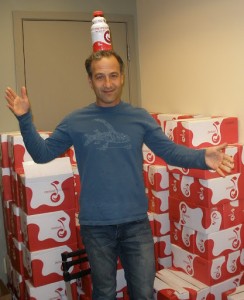Whether presented as chocolate-covered, red and luscious, or as the garnish for a sweet drink on a date, cherries have always had a strong association with Valentine’s Day. But last Feb. 14 was especially sweet for the team at CherryPharm, the company behind the line of tart cherry juices that are now known as Cheribundi.
That’s because the company consummated a deal of a different kind on the holiday, closing a $4.5 million equity round led by Greenwich-based Emil Capital Partners, along with its previous lead investor, Cayuga Venture Fund, and other shareholders.
The new cash infusion was just what the doctor ordered for Brian Ross, an entrepreneur who had previously helped grow Oregon Chai and Izze, among many other ventures. Ross, who started as the CEO of CherryPharm in June, 2010, says that with the investment, he now has room to move and build sales and marketing momentum behind the brand.
“We were underfunded for so long,” Ross said. “There was somewhat of a strategy in place, but I think we’ve been able to make things a lot more consistent.”

Consistency was a problem for the brand for several years. There was a message of functionality but not a brand message that could drive the idea that it could be an enjoyable drink. That and a name that sounded like something out of the drugstore left it largely an internet-sold anomaly.
With a change to retail and some marketing muscle behind it, however, things are starting to change. The brand has begun to rely on a national broker network – headed by Presence Marketing – to move into mainstream and natural grocery nearly simultaneously, picking up slots in Whole Foods, Hannaford, Roche, Harris-Teeter and Safeway. A tagline of “America’s Superfruit” gives it functional and semi-local connotations.
Now, as it was then, the company’s most significant brand asset is the tart cherry itself. Cheribundi had long marketed behind a few studies indicating potential anti-inflammatory effects from its high content of antioxidants called anthocyanins. Tart cherries may also offer sleep enhancement functionalities (tart cherries contain a lot of melatonin).
But that’s a heavy load for a single RTD product to carry, particularly one lacking the cash to burn that, say, a POM Wonderful brought to the table. Now, however, there is a well-funded push by the cherry growers themselves to raise the public profile of the fruit. The point man is none other than the marketer behind the “Got Milk” campaign, Jeff Manning.
Since starting with the Cherry Marketing Institute in 2009, Manning has consistently pushed the recognition of cherries so that they are now considered in the same class as blueberries and cranberries when it comes to healthy antioxidants. Tart cherries made several “trend to watch”-type lists as 2012 dawned, as well.
“We’re starting to work a lot more closely with them,” Ross said of the Cherry Marketing Institute. “It’s an asset that pomegranate never had, one that acai never had.”
But the heaviest lifting came from adjustments at Cheribundi itself. Started in 2006 by recovering Wall Streeter John Davey, CherryPharm has had several assets, including its own plant in Geneva, NY, but hasn’t has a consistent plan or feel. For a long time, most of its sales were online, and then there was the name. “CherryPharm” floundered in part because the name seemed far too medicinal for a juice that was ultimately supposed to compete against other RTD juices.
The product changed its name shortly before Ross joined; since then he has broadened the product line and begun a strong push to move the product at retail instead of through internet sales.
While the company was in about 150 stores in June 2010, it is now in more than 3000, with more retailers coming on board. On-line sales are now 10 percent of sales, down from about half. And the retail push is on: according to Ross, Cheribundi is taking a good chunk of the $4.5 million and spending heavily on field marketing and in-store demonstrations to help get the product moving.
Those products are now flavored to move better, as well. In the fall, the company debuted on-trend Ginger and Chocolate cherry blends.
Ross knows that products that depend on a single ingredient can rise or fall with the heat that surrounds them. The dream for him is for Cheribundi to start to get momentum that would put it into the position of being a nationally-recognized brand at the spear-point of a cherry-driven health trend, one fueled by NCAA and professional athletic operations that already use the product, and one that sits next to the Odwallas and Nakeds of the world in the cold box. Think Pom Wonderful, or maybe Ocean Spray.
“Our goal is to become the first brand of cherries in general,” he said.
But the nightmare is that other products will hop on the trend at the exact same time.
“What keeps me up at night is ‘when is Naked, or Odwalla, or Bolthouse going to come up with their tart cherry juice or line extension?’”